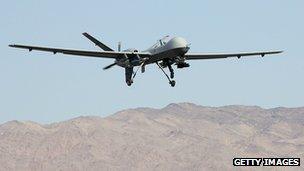The skies open up for large civilian drones
- Published
The drones that are already transforming agriculture in action
Unmanned aircraft, known as drones, are the eyes and ears of the US military, providing troops with an "eye in the sky" in situations where manned flight is considered too dangerous or difficult.
A decade ago less than five per cent of US military aircraft were unmanned, now 40 per cent have no pilot on board - from small surveillance craft light enough to be launched by hand, to medium-sized armed drones and large spy planes.
But the role of the drone is now changing. Millions of pounds are being sunk into civilian projects - everything from border security to police surveillance and even transporting goods.
This year the US Congress passed legislation giving US airspace regulator the Federal Aviation Administration (FAA) until September 2015 to open up its airspace to drones, and Britain is expected to follow suit.
The UK's airspace regulator, the Civil Aviation Authority (CAA), has told BBC Newsnight that large unmanned drones could be flying in British skies by the end of the decade.
The CAA has already handed out 120 permits to fly small, lightweight drones. By 2020 this may be extended to larger unmanned aircraft.
"In aviation terms you can probably equate where we are with unmanned technology now to manned flight in 1918 or the early 1920s," Gerry Corbett at the CAA said.
"We've found them useful in war fighting and we can see the way ahead for commercial use."
Large defence companies and small start-up firms are investing heavily in what many think could soon be a market worth tens of billions of pounds.
To date the development of unmanned aircraft has been driven by the huge increase in military spending in the aftermath of the 9/11 attacks.
Now the sensors and cameras used in drones are cheap enough for a whole raft of civilian applications to be possible.
'Quiet revolution'
Already the first tentative steps are being taken.
Five police forces have tested small, lightweight drones as an alternative to traditional air support units, although only one force - Staffordshire - still uses the device.

Reaper drones have been used by US forces to carry out missile strikes
Earlier this year Kent Police signed a deal with partners in the UK, France and the Netherlands to develop an unmanned aircraft to monitor shipping in the English Channel.
On the commercial side, small wing-shaped drones are already being used to photograph and analyse agricultural land.
The data can be used to pinpoint where extra fertilizer and pesticide is needed.
When in the air, the 2m (6.5 ft) long wings can fly by themselves from point to point using the same GPS technology found in most smartphones.
"It's potentially a quiet revolution that's going to come in," Sue Wolfe from the aerospace company Callen-Lenz, one of the two small British firms behind the project, said.
"It's a very exportable technology. You can see this scaling up for some of the big plains in Canada, for example."
But the real money in the civilian market is likely to come not from small, lightweight drones, but from much larger unmanned aircraft.
Unmanned cargo planes
The US Department of Homeland Security is already using unarmed versions of the military's Predator craft to search for illegal immigrants along the Mexican border.
Multinational freight firms like Federal Express are looking at using unmanned aircraft to deliver mail and cargo long distance.
But before the emerging civilian drone industry can really get going, some serious safety and privacy hurdles have to be overcome.
The US airspace regulator the FAA said it expects 10,000 unmanned commercial aircraft, external to be flying in American skies by 2017, a plan that has been met with some fierce criticism.
Campaigns are now underway to make a number of US cities "drone free" and politicians are debating a privacy bill which would require drone operators on the US mainland to inform the government of any data collected.
"The public is just not aware how quickly this is happening. We're talking in the US of opening up the skies by 2015 and in the UK by 2020," said privacy campaigner Chris Coles who runs the Drone Wars blog.
"There is a real failure to have a proper discussion and debate about this in the UK. Very few parliamentarians for instance are talking about this."
Avoidance systems
But behind the scenes a large amount of public money is already being spent here in Britain.
A consortium of defence companies led by BAE Systems has been given almost £31m in regional funding to try and prove civilian drones can safely share the skies with other airspace users.
Newsnight asks whether we are ready for thousands of drones patrolling our skies
Another £17m has been spent turning an old military base at Aberporth in west Wales into Europe's first centre for flying and testing civilian drone aircraft.
The key piece of technology currently missing is a "detect-and-avoid" system for civilian drones that will automatically steer the pilotless craft away from commercial airliners and crash land in a safe area if necessary.
The CAA has made it clear that it will not approve the use of drones larger than 20kg in UK airspace until it is convinced the drone can automatically sense and avoid other aircraft
"If there is an accident at this stage it would set the industry back a long way," Mr Corbett at the CAA said.
"We're not there yet but there are a lot of people working on it very closely," he added. "Whoever cracks the 'detect-and-avoid' nut first will, I think, have a winner on their hands."
BBC Newsnight's Jim Reed reports
- Published23 July 2012
- Published8 February 2012
- Published31 January 2012